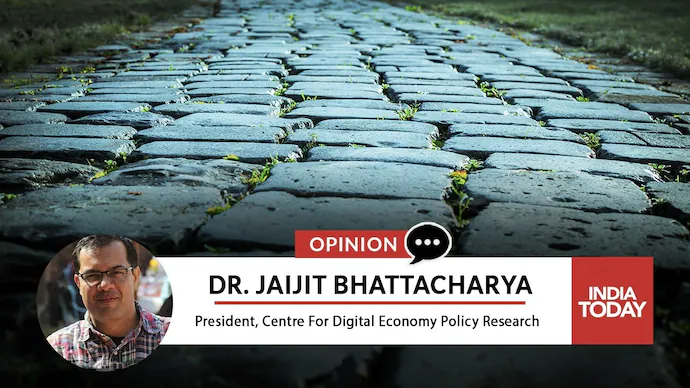
By Dr. Jaijit Bhattacharya
My first exposure to the mysterious paving stones was in Indonesia. The paving stones had a habit of getting old and dilapidated rather quickly and therefore needed to be replaced every other year. These paving stones covered the public sidewalks.
Many years later, I witnessed the same mysterious paving stones appearing on the sidewalks near the Kremlin in Moscow. What appeared to be paving stones in perfectly good condition were being replaced at great inconvenience to the pedestrians, and clearly at a great cost to the exchequer. On asking people I knew there about this mysterious situation of perfectly good paving stones being replaced, I was promptly told that the magic can be attributed to the “income-enhancing” activities of the relevant authorities.
Cut to Indian cities, and it is an annual affair that perfectly good paving stones get replaced to “beautify” the cities. And yet, India continues to live with perhaps the ugliest of cities among any major economy. Sometimes the reason given is that rough sidewalk pavings are to be replaced with in-situ created castings. The same was replaced by more “fashionable” prefab pavings. The next year they are replaced with cemented blocks. And the saga goes on, year after year, with no perceptible change to either the aesthetics of the sidewalk or the convenience of the pedestrians.
More often than not, the pedestrians, anyway, walk on the road while the sidewalks are taken over by parked cars which also break the paving stones, thus offering the perfect opportunity to replace the paving stones once again. And when they are not replaced, they are painted, only to look drained and sad the very next day, under the relentless smoke and soot from the traffic and city dust. And there we have a “side business” of continuously painting something that will always be dirty by definition.
Now it is not too strange that such mysterious paving stones are largely seen in Indonesia, Russia and India. All three are not perceived favourably on the corruption metric. It does not take much deduction to understand the motivation to continuously do public procurement of paving stones for sidewalks. In fact, a surprise inspection by a minister, a few months after a recent beautification effort of a congested pocket in Delhi revealed that the newly laid paving stones are broken and dishevelled. I am sure some agencies will promptly jump in to change the paving stones.
But how do the developed and less corrupt economies manage their sidewalks and paving stones? To begin with, they do not use paving stones in general. The regular sidewalks are cemented and no paving stone or tile is used to cover them. Thus, there is nothing to break. It is really that simple. In addition, the sidewalk is left in its natural grey cement colour, so that it “cannot” get dirty and hence there is no need to keep repainting it. It saves an enormous amount of national resources and taxpayers’ money while making the sidewalks safe for pedestrians who will not trip on broken paving stones.
So, why are we discussing in a column dedicated to everything digital, the commonly understood and surprisingly ignored issue of corruption through paving stones, and myriad other such interventions in a city? It is because there are enough tools available digitally to stop such wanton wastage of the taxpayers’ money and the misutilisation of scarce national resources. This should have been a part of the Smart City initiative. However, sadly, such digital systems are missing in smart city initiatives.
The first important step is to move from an output-based procurement to an outcome-based procurement — something that I have been tom-tomming for over two decades. We should not procure a sidewalk as a one-time procurement but procure a sidewalk as a service. What that implies is that no matter what the contractor does to construct the sidewalk, her job would be to ensure that the sidewalk stays in perfect shape, with certain standards to be followed. So it would not matter if it uses paving stones or not, it should be usable for a pedestrian. Such standards of a sidewalk can be digitally measured on a regular basis and the same can be used to reward or penalize the contractor.
Next, each part of the city should be under one single officer who is completely responsible for that area. There should be no overlapping jurisdiction of officers from multiple departments. It should be the responsibility of this officer to marshal the resources of all the departments to ensure that all city functionalities of the given area are functioning properly, including the sidewalks. What this achieves is acute answerability. There would be a single person who is accountable for say a paving stone lying on the road and causing serious accidents (of which there are numerous fatal cases).
And finally, digital should be used for participative governance, such that it is the people who agree on whether a sidewalk needs to be repaired or not. There are so many things in a city that require fixing and one often wonders on what basis the authorities are fixing a perfectly good sidewalk or a road or some such structure. Such apparently random prioritisation can be reduced through participative governance.
We are in a need to accelerate the government’s focus on digital and adopt the same much more vigorously in cities so as to “solve” the mystery of the paving stones and other similar mysteries. With the budgets of Mumbai and Chicago being comparable, one should not be left wondering why the ease of living in the two cities is so vastly different. Digital will play a significant role in bridging the gap.
This article first appeared in India Today, https://www.indiatoday.in/opinion-columns/story/mystery-paving-stones-cities-economy-digital-tools-governance-opinion-1963366-2022-06-17